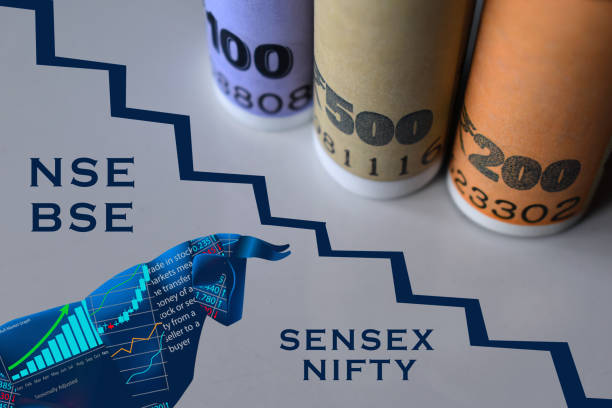
What are Sensex and Nifty? Complete Guide for Beginners
In this article, we’ll break down Sensex and Nifty in simple language so beginners can easily understand their meaning, importance, and role in the Indian stock market.
When you hear stock market news, terms like Sensex and Nifty are always highlighted. Headlines often read – “Sensex jumps 500 points” or “Nifty slips below 25,000.” But what exactly do these terms mean, and why are they so important for investors?
What is Sensex?
The Sensex, short for Stock Exchange Sensitive Index, is the benchmark index of the Bombay Stock Exchange (BSE). It represents the performance of 30 well-established and financially strong companies across various sectors of the Indian economy.
- Introduced in 1986
- Calculated using the free-float market capitalization method
- Covers companies from sectors like IT, banking, FMCG, energy, and more
Some of the major companies included in the Sensex are Reliance Industries, HDFC Bank, Infosys, TCS, and ICICI Bank.
👉 In short, Sensex shows the overall performance of India’s oldest stock exchange – the BSE.
What is Nifty?
The Nifty, short for National Stock Exchange Fifty, is the benchmark index of the National Stock Exchange (NSE). It tracks the performance of 50 large-cap companies listed on the NSE across different sectors.
- Launched in 1996
- Managed by the NSE Indices Limited (a subsidiary of NSE)
- Calculated using the free-float market capitalization method
Top Nifty companies include Reliance, Infosys, HDFC Bank, TCS, and ITC.
👉 In simple terms, Nifty is the mirror of India’s largest stock exchange – the NSE.
Sensex vs Nifty – Key Differences
| Feature | Sensex | Nifty |
|---|---|---|
| Exchange | Bombay Stock Exchange (BSE) | National Stock Exchange (NSE) |
| No. of Companies | 30 | 50 |
| Launched | 1986 | 1996 |
| Methodology | Free-float market cap | Free-float market cap |
| Managed by | BSE | NSE Indices Limited |
| Base Year | 1978–79 | 1995 |
👉 While Sensex covers 30 top companies, Nifty includes 50 companies, giving it slightly broader coverage of the market.
Why Are Sensex and Nifty Important?
- Barometers of Indian Economy – Both indices reflect the overall health of the Indian stock market and economy.
- Investor Sentiment Indicators – Rising indices show positive sentiment; falling indices show caution or pessimism.
- Benchmark for Investments – Mutual funds and ETFs compare their performance against Sensex and Nifty.
- Global Recognition – International investors use these indices to gauge India’s financial strength.
⚙️ How Are Sensex and Nifty Calculated?
Both Sensex and Nifty use the free-float market capitalization method.
Step-by-step:
- Market Capitalization = Share Price × Total Number of Shares
- Free-Float Market Cap = Market Cap × Percentage of Shares Available for Public Trading
- Index level is calculated based on the weighted average of all selected companies.
👉 Example: Reliance Industries, being India’s largest company, has the highest weightage in both Sensex and Nifty. This means a change in Reliance’s stock price impacts the indices more than smaller companies.
Global & Domestic Factors Affecting Sensex and Nifty
- Global Markets: Dow Jones, Nasdaq, and global indices influence Indian markets.
- Economic Data: Inflation, GDP growth, unemployment data.
- RBI Monetary Policy: Interest rate hikes or cuts directly affect indices.
- Corporate Earnings: Quarterly results of major companies.
- FII/DII Activity: Foreign Institutional Investors and Domestic Institutional Investors drive market momentum.
Impact on Investors
For investors and traders, Sensex and Nifty act as:
- Market Direction Indicators – If Sensex/Nifty is rising, the broader market trend is bullish; if falling, the trend is bearish.
- Portfolio Benchmark – Helps investors compare their portfolio returns with the market.
- F&O Trading Instruments – Nifty Futures & Options are the most traded derivatives in India.
Common FAQs
1. Do Sensex and Nifty always move together?
Yes, since both represent India’s large-cap companies, they generally move in the same direction, although not always with the same intensity.
2. Which is better – Sensex or Nifty?
Both are important. Nifty has broader coverage (50 stocks vs 30), while Sensex is older and more widely followed internationally.
3. Can Sensex and Nifty go negative?
No, index levels cannot be negative. They can only fall towards zero, but practically, that never happens.
4. Why do news channels highlight Sensex more than Nifty?
Sensex is older and widely recognized, but among traders, Nifty is more popular due to derivatives trading.
Conclusion
Sensex and Nifty are the heartbeat of the Indian stock market. While Sensex tracks 30 leading companies on the BSE, Nifty follows 50 top companies on the NSE. Together, they act as the barometers of India’s economic growth and investor sentiment.
If you are new to investing, regularly tracking Sensex and Nifty is the first step towards understanding market trends and making informed decisions.




